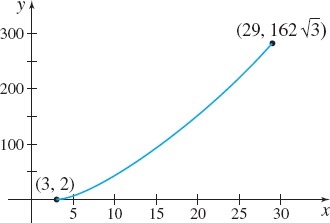EXAMPLE 5Finding Arc Length for Parametric Equations
Find the length s of the curve represented by the parametric equations x(t)=t3+2y(t)=2t9/2
from the point where t=1 to the point where t=3. Figure 16 shows the graph of the curve.

Solution We begin by finding the derivatives dxdt and dydt. dxdt=3t2anddydt=9t7/2
The curve is smooth for 1≤t≤3. Now using the arc length formula for parametric equations, we have s=∫ba√(dxdt)2+(dydt)2 dt=∫31√(3t2)2+(9t7/2)2dt=∫31√9t4+81t7dt=∫313t2√1+9t3dt
The substitution method for definite integrals is discussed in Section 5.6, pp. 391-393.
We use the substitution u=1+9t3. Then du=27t2dt, or equivalently, 3t2dt=du9. Changing the limits of integration, we find that when t=1, then u=10; and when t=3, then u=1+9⋅33=244. The arc length s is s=∫313t2√1+9t3dt=∫24410√u(du9)=19∫24410u1/2du=19[u3/232]24410=227[2443/2−103/2]=427[244√61−5√10]